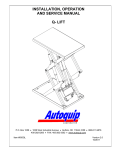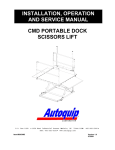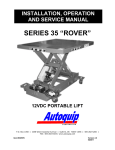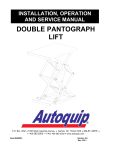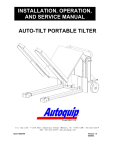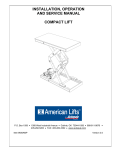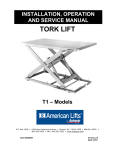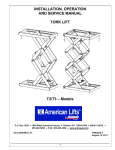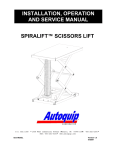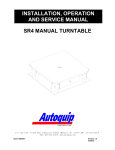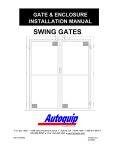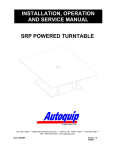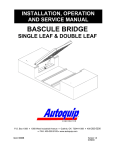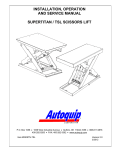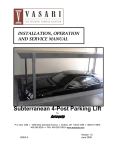Download Carousel Scissors Lift Installation, Operation and Service Manual
Transcript
INSTALLATION, OPERATION AND SERVICE MANUAL CAROUSEL SCISSORS LIFT P.O. Box 1058 • 1058 West Industrial Avenue • Guthrie, OK 73044-1058 5200 • FAX: 405-282-8105 • www.autoquip.com Item # 830 CAR • 405-282- Version 1.0 09/2001 TABLE OF CONTENTS Identification and Inspection 3 Dangers, Warnings, and Cautions 4 Label Identification 8 Specifications 12 Lift Blocking Instructions 13 Installation Instructions 15 Operating Instructions 18 Routine Maintenance 19 General Maintenance 21 Replacement Parts List 33 Troubleshooting Analysis 37 IMPORTANT Please read and understand this manual prior to installation or operation of this lift. Failure to do so could lead to property damage and/or serious personal injury. If questions arise, call a local representative or Autoquip Corporation at 1-888-811-9876 or 405-282-5200. PLANNED MAINTENANCE PROGRAM A local Autoquip representative provides a Planned Maintenance Program (PMP) for this equipment using factory-trained personnel. Call a local representative or Autoquip Corporation at 1-888-811-9876 or 405-282-5200 for more information. 2 IDENTIFICATION & INSPECTION IDENTIFICATION When ordering parts or requesting information or service on this lift, PLEASE REFER TO THE MODEL AND SERIAL NUMBER. This information is on a nameplate attached to the leg assembly. Replacement parts are available from a local Autoquip distributor. INSPECTION Immediately upon receipt of the lift, a visual inspection should be made to determine that the lift has not been damaged in transit. Any damage found must be noted on the delivery receipt. In addition to this preliminary inspection, the lift should be carefully inspected for concealed damage. Any concealed damage found that was not noted on the delivery receipt should be reported in writing to the delivering carrier within 48 hours. The following is a checklist that will aid in the inspection of the lift. 1. Examine entire unit for any signs of mishandling. Pay special attention to the power unit and controls. 2. Thoroughly examine all connections, making sure they have not vibrated loose during transit. 3. After installation, raise the lift and inspect the base frame and scissors assembly. 3 DANGERS, WARNINGS & CAUTIONS SAFETY ALERTS (Required Reading!) The following SAFETY ALERTS are intended to create awareness of owners, operators, and maintenance personnel of the potential safety hazards and the steps that must be taken to avoid accidents. These same alerts are inserted throughout this manual to identify specific hazards that may endanger uninformed personnel. Identification of every conceivable hazardous situation is impossible. Therefore, all personnel have the responsibility to diligently exercise safe practices whenever exposed to this equipment. ____________________________________________________________ DANGER! Identifies a hazardous situation that presents the imminent probability of death or of severe personal injury!! _____________________________________________________________ WARNING! Identifies a hazardous situation that has the potential of causing death or serious personal injury. _____________________________________________________________ CAUTION! Identifies a hazardous situation that could lead to the possibility of personal injury of death, and/or may result in equipment damage. _____________________________________________________________ 4 DANGERS, WARNINGS & CAUTIONS Read and understand this manual and all labels prior to operating or servicing the lift. All labels are provided in accordance with ANSI Z535.4. DANGER! Do not work under lift without maintenance device! To avoid personal injury, NEVER go under the lift platform until the load is removed and the scissors mechanism is securely blocked in the open position. See "Lift Blocking Instructions" section. DANGER! To avoid personal injury, stand clear of scissors leg mechanism while lift is in motion. DANGER! HIGH VOLTAGE!! Disconnect and/or lock out the electrical supply to the power unit prior to any maintenance being performed. DANGER! Do not attempt to remove the velocity fuse until the maintenance leg securely supports the lift and all hydraulic pressure has been removed from the lifting cylinders and hydraulic hoses. Failure to do so could results in personal injury or death! 5 DANGERS, WARNINGS & CAUTIONS DANGER! Extending the platform length or width beyond the factory limit could cause the unit to tip, which could result in personal injury or death. WARNING! Do not operate this equipment without handrails and snap chains in place. WARNING! Under no circumstances should the speed control orifice be removed from the Deltatrol to obtain faster lowering speed. A loaded lift can reach dangerous and destructive speed!! WARNING! All warning and information decals should be in place as outlined in the “Label Identification” section. If decals are missing or damaged, they should be replaced with new ones. Contact an Autoquip representative for replacements. WARNING! Lift platforms traveling below floor levels my create openings, and the shape of the load and how the load is arranged on the lift may create a toe hazard as the load passes the top edge of the pit. Both situations may require guarding in accordance with Federal Regulations. Any such guarding must be installed prior to operating the lift. 6 DANGERS, WARNINGS & CAUTIONS CAUTION! Never run the pump for more than a couple of seconds without pumping oil. This applies to low oil conditions, improper motor rotation, running the pump against the relief pressure after the lift is fully raised against the physical stops, running overloaded beyond capacity, or running at reduced speed because of pinched or obstructed hydraulic lines. CAUTION! Do not continue to depress the “UP” button on the controller if the lift is not raising or if the lift has reached the fully raised position. To do so may result in permanent damage to the motor or pump. CAUTION! Do not operate the power unit on relief for more than a few seconds. When on relief, the valve will make a squealing sound. CAUTION! Precautions should be taken to prevent the introduction of contaminates such as dirt or other foreign material into the system through open fittings, pipes or disassembled components. Contamination will ruin the hydraulic system. CAUTION! Use only approved oils in the lift. See “Specifications” section. 7 LABEL IDENTIFICATION 5 8 5 1 3 2 6 2 4 7 6 Figure 1 Label Placement CAROUSEL Item No. Qty Description Part No. 1 2 Capacity 2 4 Danger – Do Not Put Hands Or Feet . . . 3 2 Caution: Familiarize Yourself With Operators Manual 36401487 4 1 Autoquip Serial Number Nameplate 36401511 5 2 Warning: Do Not Operate This Equipment Without . . . 36403715 6 2 Leg Socket 36400265 7 1 Maintenance Device 36400257 8 2 Warning: Keep Gate Closed . . . 36403699 36401594 8 36430050M LABEL IDENTIFICATION Note: Labels shown here are not actual size. Figure 2 Label 36401594 CUT LINE Figure 3 Label 36430050M Figure 4 Label 36401487 9 LABEL IDENTIFICATION Figure 5 Label 36401511 Figure 6 Label 36403715 Figure 7 Label 36400265 10 LABEL IDENTIFICATION Figure 8 Label 36400257 Figure 9 Label 36403699 11 SPECIFICATIONS Model Lowered Height (inches) Travel (inches) Lift Cap (lbs) Side Load Cap (lbs) End Load Cap (lbs) Base Size (inches) Std. Minimum Platform Size (inches) Max Allowable Platform Size (inches) Lift Weight (lbs) 7220 8 72 2,000 1,000 500 58 X 96 72 X 102 72 X 168 4,000 8420 8 80 2,000 1,000 500 58 X 111 72 X 120 72 X 168 4,300 9620 12 96 2,000 1,000 500 58 X 140 72 X 144 72 X 168 4,500 NOTE: All models travel a speed of 20 fpm. LOAD CAPACITY The load capacity rating is stamped on a metal plate attached to one side of the lift. This figure is a net capacity rating for a lift furnished with the standard platform. The relief valve of the pumping unit has been set to raise the weight, plus a small amount for overload. Where equipment, special attachments, etc, are installed on the lift after leaving the plant, deduct the weight of these from the load rating to obtain the net capacity. Lifts should not be overloaded beyond the established capacity as damage and/or personal injury may result. UNBALANCED LOADING The stabilization provided is basically for balanced loads. If special attachments extend beyond the length and/or width dimensions of the platform, the end and/or side load capacity must be reduced (contact an Autoquip Sales representative). PUMP PRESSURE This lift incorporates a positive displacement pump machined to a high degree of accuracy and specially adapted to requirements of higher-pressure ranges over that of a standard pump. Standard factory models of the same manufacture cannot replace it. The pump can operate efficiently at intermittent pressures up to 3200 PSI and continuous duty to 2500 PSI. However, the safety relief valve in the power unit is factory-set considerably below 3,200 psi to stay within the parameters of the maximum lifting capacity. 12 LIFT BLOCKING INSTRUCTIONS 1. Remove all load from the platform. Never block the lift when loaded, only when empty. 2. Raise the lift platform fully by depressing the “UP” button. 3. The maintenance leg is stored on the clevis end of the lift. Place the end of the maintenance leg in the socket on the base frame of the lift. 4. Begin lowering the platform by activating the “DOWN” valve until the scissors mechanism is resting on the maintenance leg. Continue activating the “DOWN” valve five to ten seconds to relieve the pressure in the line. 5. Check to be certain that the maintenance leg is securely in the socket on the platform and the socket on the base frame. DANGER! HIGH VOLTAGE!! – Disconnect and/or lock out the electrical supply to the power unit prior to any installation or maintenance being performed. 6. To remove the maintenance leg, raise the platform by activating the “UP” valve to provide sufficient clearance for the removal and storage of the maintenance leg. 13 LIFT BLOCKING INSTRUCTIONS DANGER! To avoid personal injury, NEVER go under the lift platform until the load is removed and the scissors mechanism is securely blocked in the open position. MAINTENANCE LEG MAINTENANCE LEG SOCKET Figure 10 Maintenance Leg 14 INSTALLATION INSTRUCTIONS 1. The surface area where the lift will be set must be flat and level and be of sound concrete of sufficient thickness to support the lift while loaded at full capacity. 2. For beveled toe guard models, the surface area must have a recess to allow hydraulic lines to pass under the ends of the base frame. Hydraulic lines must be protected or placed in a way that they are free from possible damage. 3. The base of the lift must be lagged down in the holes provided. Lag bolts should be able to withstand 2000 lbs. minimum upward pull at each corner. 4. Shims and/or grout may be required to insure support of the entire base frame and platform support members. DO NOT “spot” shim! Shims and/or grout must be able to support the lift while loaded at full capacity. 5. Optional floor ramps are available. Consult a local Autoquip dealer. 15 INSTALLATION INSTRUCTIONS PROCEDURE FOR A LIFT ORDERED WITH AN ACCORDION SKIRT 1. Position the platform in the raised position. Install the maintenance locks (see “Lift Blocking Instructions” section). Position the accordion with the weight rod pocket at the bottom and the mounting collar at the top. The breathable material when provided must be positioned at the top of the skirt with the mounting collar. 2. Slip the skirt over the end of the platform. Turn the skirt as required to slide over the other end of the platform and leg assembly. The skirt should be in position under the platform while enveloping the base assembly. 3. See Figure 11 and select the correct mounting configuration (Number 1, 2, or 3). Figure #1: Mounting an Accordion Skirt Onto the Platform Side Raise one side of the skirt along with a skirt -mounting bar (1/8” x 1”) to (1) side of the platform. When possible, center the skirt-mounting collar and skirtmounting bar (1/8” x 1”) on the platform side. Align the pre-drilled holes in the side of the platform with the skirt-mounting bar holes and punch holes in the skirtmounting collar. Push a nylon drive rivet through each hole in the skirt-mounting bar. Hammer the aluminum pin into the rivet until flush with the rivet head. Repeat mounting process for the remaining sides of the accordion skirt. Figure #2: Mounting an Accordion Skirt Underneath the Platform Raise one side of the skirt along with a skirt-mounting bar (1/8" x 1") to the underside of the platform skirt support bar. When possible, center the skirt mounting collar and the skirt-mounting bar (1/8” x 1”) on the platform support bar. Align the pre-drilled holes in the skirt support bar (picture frame) with the skirt mounting bar holes and punch holes in the skirt-mounting collar. Push a nylon drive rivet through each hole in the skirt-mounting bar. Hammer the aluminum pin into the rivet until flush with the rivet head. Repeat mounting process for the remaining sides of the accordion skirt. Figure #3: Mounting an Accordion Skirt Onto the Bevel Toe Guard Raise one side of the skirt along with a skirt-mounting bar (1/8” x 1”) to the side of the bevel toe guard. When possible, center the skirt mounting collar and the skirt-mounting bar (1/8” x1”) on the platform bevel toe guard. Align the pre-drilled holes in the bevel toe guard with the skirt-mounting bar holes and punch holes in the skirt-mounting collar. Push a nylon drive rivet through each hole in the skirtmounting bar. Hammer the aluminum pin into the rivet until flush with the rivet head. Repeat mounting process for the remaining sides of the accordion skirt. 4. Install weight rods into the weight rod pockets at the bottom of the accordion skirt. Install the spring tempered wire rods into the pocket of black convolutions. 16 INSTALLATION INSTRUCTIONS Figure 11 Field Installation Diagram for Mounting Accordion Skirts 17 OPERATING INSTRUCTIONS Familiarize yourself with this operator’s manual before operating the equipment!!! 1. Scissors lifts have maximum lifting capacity ratings (see “Specifications” section). The safety relief valve has been factory set to open at a pressure slightly above the rated load capacity and allows the oil to bypass into the reservoir to prevent damage to the lift and its hydraulic power unit. The safety relief valve should not be adjusted for any reason as it could cause the motor to prematurely burn out. Applying loads exceeding the rated capacity of the lift may result in excessive wear and damage to the lift. 2. This type of lift is designed primarily for carousel picking applications and is typically furnished with constant pressure pushbutton controls. Actuating the "UP" button will cause oil to enter the cylinders and the lift will rise. 3. When the desired height or upward travel of the platform is attained, removing pressure from the switch deactivates the “UP” circuit button. The oil stops flowing and the upward movement will stop. 4. Activate the "DOWN" button to lower the lift. Opening the down control valve allows the oil in the cylinders to flow through the down valve at a controlled rate and return oil to the reservoir. 5. When the desired height or downward travel of the platform is attained, removing the operator’s foot or hand from the switch deactivates the “DOWN” circuit. The oil stops flowing from the cylinders and the downward movement will stop. CAUTION! Do not continue to activate the "UP" button if the lift is not raising or if it has reached the fully raised position. To do so may result in permanent damage to the lift. CAUTION! Do not operate the power unit on relief for more than a few seconds. When on relief, the valve will make an audible squealing sound. 18 ROUTINE MAINTENANCE Normally scissors lifts will require very little maintenance. However, a routine maintenance program could prevent costly replacement of parts and/or downtime. WARNING! To avoid personal injury, NEVER go under the lift platform or perform any maintenance on the lift until the load is removed and the scissors mechanism is securely blocked in the open position. See "Lift Blocking Instructions" section. MONTHLY INSPECTION: 1. Check oil level (see oil recommendations in this section) and add appropriate oil when necessary. 2. Check for any visible leaks. Correct as necessary. 3. Check any unusual noise when it occurs. Determine the source and correct as necessary. 4. Check the snap rings at all rollers, if not in place, and/or secure, replace or repair immediately. 5. Check all rollers for signs of wear. Replace as necessary. 6. Do not grease roller or axles; they have lifetime-lubricated bearings. 7. Check all wiring for looseness or wear. Repair at once. OIL REQUIREMENTS: Change oil yearly, or more frequently if it darkens materially or feels gummy or gritty. Use detergent motor oils only. Do not use hydraulic-jack oil, hydraulic fluids, brake fluids, or automatic transmission fluid. 19 ROUTINE MAINTENANCE Oil Viscosity Recommendations Environment (Ambient Temperatures) Recommended Oil Indoor location, variable temperatures (30 - 100° F) 10W30 or 10W40 Multiviscosity motor oil Indoor location, consistent temperatures (70° F) SAE-20W motor oil Outdoor location, (-10 - 100° F) SAE 5W30 Multiviscosity motor oil Cold-storage warehouse (10 - 40° F) 5W30 Multiviscosity motor oil Freezer (-40° F to 0° F) Consult Factory OIL CAPACITY: Reservoir capacity for the steel “vertical” tank is approximately 11 gallons. The oil level in the reservoir should be 1” to 1 _” below the top of the reservoir with the lift in the fully lowered position. PIPE THREAD SEALANT Loctite PST #567 pipe thread sealant or equivalent is recommended. Do not use Teflon tape. Tape fragments can cause malfunctioning of the hydraulic system. 20 GENERAL MAINTENANCE 1. Change oil once a year or when it materially darkens or feels gritty. Also, check oil for the presence of water (oil will turn milky in color.) 2. NEVER TRY TO DISASSEMBLE OR REPAIR A PUMP IN THE FIELD. These pumps are high-precision devices requiring extreme precision in fit-up. When one is damaged, there is seldom anything that can be repaired in the field. It is also more economical to replace a pump than to refit old parts with new parts. 3. The pin, or roller bushing should be replaced whenever excessive wear is detected. The rollers are furnished with the pressed-in bushing as a unit part. DANGER! To avoid personal injury, NEVER go under the lift platform until the load is removed and the scissors mechanism is securely blocked in the open position. POWER UNIT DANGER! HIGH VOLTAGE!! Disconnect and/or lock out the electrical supply to the power unit prior to any maintenance being performed. 1. The “vertical” unit utilizes a heave duty 5 HP/208, 230, or 460 Volts/60 hertz/3 phase motor coupled to a high-pressure positive displacement gear pump, and Autoquip Corporation’s patented Deltatrol valve assembly. It is also available with a 5 HP/115 or 230 Volts/60 hertz/single-phase motor as an option. 2. The following should be referenced in connecting the standard heavy-duty motors to power sources. Remember that heavy wire must be used all the way to the power source. Power Unit 115 Volts 208 Volts 230 Volts 460 Volts Standard Three Phase N/A 16 AMPS 15.2 AMPS 7.6 AMPS Standard Single Phase 58 AMPS N/A 24.5 AMPS N/A NOTE: All amperage draws shown are full-load amperages. 21 GENERAL MAINTENANCE CYLINDER REMOVAL AND REPACKING (see figure 12) 1. Raise the lift to its full height and block securely. See “Lift Blocking Instructions”. 2. Loosen and remove the cylinder hose at the hose union in the tee connection between the two cylinders. Place the open end of the hose in a container to receive oil spillage. 3. Remove the pin retaining screw in the cylinder clevis or pin retaining rings, and carefully tap out the clevis pin to avoid damaging the clevis pin bushings. 4. Remove the cylinder from the lift. 5. Push the piston rod into the tube to eject as much oil as possible into a container. 6. Pull the rod out of the cylinder tube sufficiently to gain access to the face spanner wrench holes on the rod end of the cylinder. Do not allow oil or dirt to be pulled back into the hydraulic hose. 7. Using a face spanner wrench, turn the bearing assembly clockwise until the tip of the retainer appears in the slot in the outer surface of the cylinder tube. 8. Insert a small blade screwdriver under the tip of the retainer and turn the bearing assembly counter-clockwise until the retainer is free of the slot. NOTE: The wire retainer may be a cutting or puncturing hazard. 9. Pull the rod out of the tube slowly to remove the rod and bearing assembly. NOTE: Use caution to prevent surface damage to the rod. This could result in seal failure and/or leakage. 10. Inspect the bore of the tube. Hone if necessary to remove any surface imperfections in the bore. Flush thoroughly after honing to remove chips and grit. 11. Remove the piston lock nut and slide off the piston and bearing assembly. Take care to protect the rod surface from damage. 12. Install new packing and seals on the piston, rod, and bearing assembly. Inspect all grooves and seal surfaces for any imperfections and repair or replace as necessary. 13. Grease all seals and packing liberally and install the bearing assembly and the piston on the rod and torque the lock nut to 500 ft. lbs. 22 GENERAL MAINTENANCE 14. Install the rod into the tube using care not to damage any seals or packing 15. Align the retainer hole in the bearing assembly groove with the slot in the tube. 16. Insert the retainer hook end in the hole/slot and using a face spanner wrench, turn the bearing assembly clockwise until the retainer is completely inserted in the groove/slot in the tube. 17. Check the clevis pin bushings in the cylinder rod for wear and replace as necessary. 18. Install the assembled cylinder into the lift by carefully driving the clevis pin through the clevis and cylinder rod. Extreme care must be taken to prevent damage to the clevis in the bushings. Install the pin retaining screw with washers, engaging the slot in the pin, and torque to 25 ft. lbs. or the retaining rings and washers on the pin (cylinder rod may be extended by hand.) 19. Connect the cylinder hydraulic hose and the tee using the recommended sealant. 20. Check all pins and other mechanical as well as hydraulic components to assure that the assembly is complete and in good working order. 21. Turn the electrical supply back on and press the “UP” button on the controller to raise the lift. NOTE: 15 to 30 seconds time may elapse to fill the empty cylinders before movement is noted. 22. Remove and place the maintenance leg in its storage location, then press the “DOWN” button on the controller to cycle the lift to the fully lowered position. Hold the “DOWN” button 30 to 40 seconds to allow air in the cylinders to bleed back into the reservoir tank. 23. Cycle the lift 10 to 15 times and repeat the bleeding operation by holding the ”DOWN” button for 30 to 40 seconds. 24. Check the oil level in the reservoir with the lift in the fully lowered position. Add as necessary (see “Routine Maintenance” for oil recommendations). 25. Clean the oil filler breather cap if it appears dirty. 26. Clean up any debris and or spilled oil from the area. NOTE: Depending on experience, the job should take one to two hours. 23 GENERAL MAINTENANCE Figure 12 Hydraulic Cylinder 24 GENERAL MAINTENANCE VELOCITY FUSE REPLACEMENT DANGER! Do not attempt to remove the velocity fuse until the lift is securely supported with the maintenance locking devices and all hydraulic pressure has been removed from the lifting cylinders and hydraulic hoses. Failure to follow these instructions could result in personal injury or death! Never attempt to take a velocity fuse apart and repair it. These are precision devices that are factory assembled under exacting conditions. Velocity fuses should always be replaced. 1. The arrow on the exterior surface of the velocity fuse shows the direction of the restriction to the oil flow. The arrow should always point away from the cylinder. 2. Do not use Teflon tape on the threaded connections of a velocity fuse. Tape fragments can cause malfunctioning of the fuse. 3. Check all fitting connections for hydraulic leaks and tighten as necessary. HOSE ORIENTATION To prevent damage to the cylinder hose and possible failure of lift, it is necessary to establish a correct hose shape and pattern of movement as follows: 1. Raise the lift to its full height and block securely. See “Lift Blocking Instructions”. 2. Install one end of the new hose to the cylinder elbow fitting. 3. Since the hose is fixed at both ends, it is possible to put a twist in the hose that will allow it to describe the same pattern each time the lift is operated. This twist will allow the hose to travel about half way between the cylinder on the right side and the inner leg on the right side. 4. Lower the lift carefully and check to see that the hose is free and clear of the cylinder and the inner leg assembly. If not, twist the hose in the direction necessary to clear it of any obstruction and then lock the swivel fitting securely. 25 M 26 SUCTION LINE RELIEF VALVE SUCTION LINE FILTER IS INTERNAL TO DELTATROL BLOCK UNLESS A SEPERATE FILTER IS SPECIFIED. FILTER P.F. CHECK VALVE RESERVOIR DOWN SPEED RESTRICTOR RETURN LINE FILTER LOWERING VALVE AND PRESSURE LINE FILTRATION. COMPENSATED FLOW CONTROL, SOLENOID DELTATROL VALVE PROVIDES COMPLETE, THE FUNCTION OF CHECK, RELIEF, PRESSURE PRESSURE LINE VELOCITY FUSES (1) VELOCITY FUSE PER CYLINDER. QUANTITY OF CYLINDERS AND VELOCITY FUSES DEPENDS ON MODEL OF LIFT USED. LIFTING CYLINDERS GENERAL MAINTENANCE Figure 13 Hydraulic Schematic – Vertical Power Unit GENERAL MAINTENANCE Figure 14 Electrical Schematic – 208-230-460 Volt Three Phase 27 GENERAL MAINTENANCE Figure 15 Electrical Schematic 230 V/1PH 28 GENERAL MAINTENANCE Figure 16 Electro-Hydraulic Schematic – Soft Start/Soft Stop Option 29 GENERAL MAINTENANCE Figure 17 Uptravel Limit Switch Location 30 GENERAL MAINTENANCE Figure 18 – Gate Interlock Limit Switch Location 31 7/16" HOLE DRILLED IN PLATFORM AT LOCATION OF LOCKING PIN. SEE PLATFORM DRAWING. "A" 2 1/8" 1/8" ITEMS #2 THRU #9 NOT SHOWN IN THIS VIEW FOR CLARITY. UNDERSIDE OF PLATFORM (REF.) 1 1 VIEW "A-A" 4 5 "A" UNDERSIDE OF PLATFORM (REF.) MOUNTING BRACKET LOCATION DETAIL 3" 3 2-1/2" 3" (REF.) 19/32" C 3" <2T APPROXIMATE WEIGHT: REFERENCE DWG. 1 DATE: DRAWING TITLE NO. 5 4 3 2 6 JOB NAME: ITEMS #6 THRU #9 NOT SHOWN. 1 of 1 PAGE: REV. 6 TOLERANCES UNLESS OTHERWISE SPECIFIED: BY SIZE AQJ NO. DATE +/- 1/32 FRACTIONS: DECIMALS: ONE PLACE .X +/- .1 TWO PLACE .XX +/- .03 THREE PLACE .XXX +/- .010 +/- 1/2~ ANGLES: BREAK ALL SHARP EDGES: .010 MAX. x 45~ CHAMFER 351-0192-2 DRAWING NUMBER: REVISIONS LIMIT SWITCH TO BE MOUNTED UNDER PLATFORM TO SENSE THE GATE LOCKING PIN. SWITCH TO BE WIRED NORMALLY OPEN HELD CLOSED (BY THE PIN) AND WIRED TO THE J-BOX ON THE LEG OR PLATFORM. This drawing is the sole property of Autoquip Corp. and cannot be used for design & construction without permission of Autoquip Corp. 1997 2. 1. ITEM #1 DETAIL 3-1/2" 2-11/32" (4) #10-24 TAPPED HOLES. (1) REQUIRED PER LIFT NOTE: THIS EDGE TO BE WELDED TO UNDERNEATH SIDE OF PLATFORM. 7/16" C 1/8" 32 2" 1" (REF.) 4 2 UP SLOW LIMIT SWITCH ACTUATOR BAR. 2 2 BASE CLEVIS UP-SLOW LIMIT SWITCH ACTUATOR BAR. 11 11 BASE FRAME 2 2 5 3 9" 6 7 2" 1 6 7 4 3 1-1/4" 6" (REF.) 1/8" Figure 19 – Limit Switch Location – Soft Start/Soft Stop ITEMS #4 THRU #10 NOT SHOWN THIS VIEW. 8" MAINTENANCE LEG STORAGE SOCKET. SEE BASE FRAME DWG. FOR LOCATION. UP SLOW LIMIT SWITCH MOUNTING PLATE. 1 2 3/4" 2 1/8" 1/8" 4" (REF.) 1 1"-3" 1"-3" C <2T APPROXIMATE WEIGHT: REFERENCE DWG. DATE: DRAWING TITLE JOB NAME: NO. 1 2 1 of 1 PAGE: REV. ITEM #10, 6" X 6" X 6" ELECTRICAL ENCLOSURE, TO REPLACE 4" X 4" X 2" J-BOX ON OPPOSITE LEG SET. 3. 4 3 DOWN-SLOW LIMIT SWITCH TO BE SET FOR LAST 12" OF DOWN TRAVEL. UP-SLOW LIMIT SWITCH TO BE SET FOR LAST 12" OF UP TRAVEL. 2. 1. This drawing is the sole property of Autoquip Corp. and cannot be used for design & construction without permission of Autoquip Corp. 1997 DOWN SLOW LIMIT SWITCH ACTUATOR PLATE. TYP. INNER LEG 3 DOWN SLOW LIMIT SWITCH MOUNTING PLATE. 3 6 7 5 3 "DOWN-SLOW" LIMIT SWITCH 1 SECTION "A-A" ITEMS #8 THRU #10 NOT SHOWN THIS VIEW. 4 3 INNER LEG UP-SLOW LIMIT SWITCH BASE CLEVIS BASE FRAME 2 2 2 2 4 BY DATE SIZE AQJ NO. 351-0209-4 DRAWING NUMBER: REVISIONS TOLERANCES UNLESS OTHERWISE SPECIFIED: +/- 1/32 FRACTIONS: DECIMALS: .X +/- .1 ONE PLACE .XX +/- .03 TWO PLACE THREE PLACE .XXX +/- .010 +/- 1/2~ ANGLES: BREAK ALL SHARP EDGES: .010 MAX. x 45~ CHAMFER C GENERAL MAINTENANCE REPLACEMENT PARTS LIST LEG ASSEMBLY PARTS LIST QTY Part No. Description 4 Pin, leg clevis, 1 1/8” x 2” long 52502705 4 Pin, leg clevis, 1 1/2” x 2 15/16” long w/2-ring grooves 4 Bushing, 1 1/8” ID x 1” long 20022877 2 Bushing, 1 1/2” ID x 2” long 20024006 2 Washer, 1/8” TK x 1 _” ID x 2 _” OD, steel 24024507 2 Retaining Ring, 1 _” heavy duty 45400249 4 Washer, 1/8” TK x 1 _” ID x 2 _” OD, plastic 24094518 4 Washer, 5/16” STD steel 24050163 2 Cap Screw, 3/8” – 16 x 1” long 22031132 2 Pin, Cylinder Clevis, 1 1/8” x 7” long w/ 1 ring groove 52502440 2 Pin, Cylinder Clevis, 1 1/8” dia x 4 _” long w/2 ring grooves 52500196 4 Washer, 1/16” TK x 1 1/8” ID x 2” OD, plastic 24092306 4 Roller w/ Bushing, _” TK x 1 1/8” ID x 3” OD 52600269 4 Washer, 1/16” TK x 1 1/8” ID x 2” OD, steel 24012353 4 Pin, Leg Roller, 1 1/8” dia x 2 3/32” long w/1 ring groove 52502432 4 Retaining Ring, Leg Roller Pin, 1 1/8” 45400082 8 Washer, 1/16” TK x 1 1/8” ID x 2” OD, plastic 24092306 2 Pin, Inner Leg Roller, 1 _” dia x 2 7/8” long 33 N/A N/A REPLACEMENT PARTS LIST POWER UNIT PARTS LIST QTY 1 Description Part No. 1 Motor, 5 HP 208/230/460 Volt 3 PH straight shaft 30600449 1 Motor Coupling, Lovejoy L-095, 1 1/8” bore 20000154 1 Pump Coupling, Lovejoy L-095, 7/16” bore 20000030 1 Coupling Rubber Spider 20000162 1 Pump, 2.25 GPM with straight shaft 40300162 2 _” Dyna-Seal Washer for Deltatrol 45901014 1 Return Pipe Assembly, 6” long 41050485 1 Sump Strainer 47700075 1 Hose, Pump to Deltatrol, 3/8” x 18” long w/ 1 swivel 46100020 1 Deltatrol Kit 41050880 1 Down Solenoid, 24 volt 32701380 1 Down Solenoid, 115 Volt 32701370 1 Filler/Breather Cap Assembly 47700208 1 Oil Reservoir, 16” x 16” x 10” 64000813 1 Control Panel, 460 VAC/24 VAC controls 35150081 1 Control Panel, 208-230 VAC/24 VAC controls 35150080 1 Control Signal; Pushbutton – “UP”/”DOWN” 36201820 1 Dump Valve, Soft Start/Soft Stop 41302480 Flow Control, soft start/soft stop 41502626 34 REPLACEMENT PARTS LIST Figure 20 Vertical Power Unit Parts Detail 35 REPLACEMENT PARTS LIST HYDRAULIC PARTS LIST ITEM No. QTY Description Part No. 72” & 84” Travel Models Part No. 96” Travel Models 1 2 Cylinder, 3 _” bore x 11 _” stroke 42400731 N/A 1A 2 Packing Set for Single Cylinder (for part # 42400731) 45503070 N/A Packing Set for Single Cylinder (for part # 42700831) N/A 45503170 2 2 Hydraulic elbow, _” MP – _” MP 26100370 26100370 3 2 Velocity Fuse 41800558 41800558 4 1 Hydraulic Hose, _” x 24” long w/ swivel one end only 46000490 46000490 5 1 Hydraulic Hose, _” x 9” long w/ swivel one end only 46000022 46000022 6 1 Hex Reducer Bushing, 3/8” to _” 26300103 26300103 7 1 Hydraulic Tee, 3 way 3/8” FP 26150102 26150102 8 1 Hydraulic Hose, 3/8” with swivel one end only 46100095 46100103 9 1 Hex Reducer Bushing, _” to 3/8” 26305086 26305086 10 1 Pipe Elbow 90°, _” NPT 25070251 N/A N/A 25380080 52200029 N/A Reducer Coupling, _” to 3/8” 11 1 Hose Clamp Set Cylinder, 4” bore x 15 7/16” stroke N/A 36 42700831 Figure 21 Hydraulic Parts Detail 37 TROUBLESHOOTING ANALYSIS DANGER! To avoid personal injury, NEVER go under the lift platform until the load is removed and the scissors mechanism is securely blocked in the open position. See "Lift Blocking Instructions" section. PROBLEM POSSIBLE CAUSE AND SOLUTION Lift does not raise. • The motor voltage/wiring may be incorrect. • The hydraulic line or hose may be leaking. • Oil in the reservoir may be low. Add oil as necessary (See the “Routine Maintenance” section.) • The load may exceed the rating. (See the “Specifications” section.) • The suction screen may be clogged. Remove and clean the screen. Drain and replace the oil. • The suction line may be leaking air due to a loose fitting. Tighten as needed. • The breather holes in the reservoir fill plug may be clogged. Remove and clean. • The "Down" valve may be energized by faulty wiring or stuck open. Remove the solenoid and check. • The power unit pump may be defective • The structural members of the lift may be in a bind. • The manual lowering device may be engaged. Lift seems bouncy during operation. • There may be air in the hydraulic system. Bleed the air from the cylinder • Oil in the reservoir may be low. Add oil as necessary (See the “Routine Maintenance” section.) • The power unit suction strainer may be clogged. • The power unit suction line may be leaking. • There may be foreign material on the roller plate. 38 TROUBLESHOOTING ANALYSIS PROBLEM Lift will not lower. POSSIBLE CAUSE AND SOLUTION The down solenoid may be malfunctioning. The maintenance leg could be installed. The structural members may be in a bind. The tubing or hose is obstructed or broken. Check for obstruction in the line. • The return filter may be clogged. • The velocity fuse may be locked. Do not attempt to remove the velocity fuse. The following steps should be followed: • • • • 1. Remove the load from the lift. Inspect all fittings, hoses, and other hydraulic components for leads or damage. 2. If no leak or damage is noticed, attempt to pressurize the lifting cylinder by depressing the “UP” button on the controller for a few seconds. Immediately up releasing the “UP” button, depress the “DOWN” button. If the lift starts to lower, continue pressing the “DOWN” button until the lift is in the fully lowered position. 3. If the lift does not lower after trying Step 2, wait approximately 10 – 15 minutes for the pressure in the hydraulic system to equalize. Then, depress the “DOWN” button until the lift is in the fully lowered position. 4. Once the lift is in the fully lowered position, bleed the air from the hydraulic system by depressing the “DOWN” button. Hold the “DOWN” button for approximately 60 seconds. This step may need to be repeated several times to fully remove the air in the system by raising the lift to 50% of its travel and then lowering it. • Should the above steps not correct the problem, contact Autoquip to obtain instruction for further action. 39 TROUBLESHOOTING ANALYSIS PROBLEM Lift raises slowly. POSSIBLE CAUSE AND SOLUTION • The structural members of the lift may be binding. • The tubing or hose is obstructed or broken. Where pipe is used, check for obstruction in the line. • The hydraulic line or hose may be leaking. • The oil viscosity is not suited for the environmental conditions. Refer to “Routine Maintenance” section for oil recommendations. • Check the oil level in the reservoir. • The motor voltage/wiring may be incorrect. • The suction screen may be clogged. Remove and clean the screen. Drain and replace the oil. • The suction line may be leaking air due to a loose fitting. Tighten as needed. • The breather holes in the reservoir fill plug may be clogged. Remove and clean. • The power unit pump may be defective. Lift lowers slowly. • The structural members of the lift are binding. • The tubing or hose is obstructed or broken. Where pipe is used, check for obstruction in the line. • The oil viscosity is not suited for the environmental conditions. Refer to “Routine Maintenance” section for oil recommendations. • The return filter may be clogged due to dirt or damage. 40 TROUBLESHOOTING ANALYSIS PROBLEM Lift will not remain in raised position. POSSIBLE CAUSE AND SOLUTION • The cylinder packing may be leaking. • The pump or Deltatrol regulator is not seating. • The pump or Deltatrol check valve is not seating. • The hydraulic tubing, hose, or fitting is leaking oil. • The return filter may be clogged. 41









































